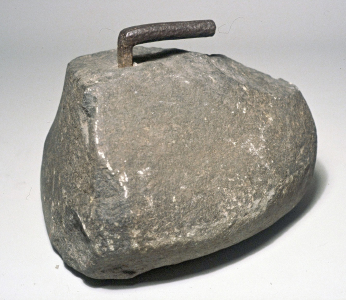Scottish curling
For centuries curling has been a favourite game in Scotland. In fact, curling is widely regarded as a Scottish pastime. Curling did not become known to the public very long ago. It was recognised as an Olympic sport in 1998. The same year it also became part of the Winter Olympic Games.
Curling is known to have originated in Scotland. Researchers believe that a game similar to curling may have originated in the 16th century. The discovery of a stone at the bottom of a dried-up body of water, similar to the one used in curling, confirms this fact. The date 1511 was carved into the stone. In the annals curling was mentioned in 1541 when the monk John Sclater challenged the Abbey’s representative Gavin Hamilton to a curling match.
Ancient curling stone
At the same time in the Netherlands, peasants played a very similar game to curling called ‘icestock’. Curling quickly caught on there as the Dutch had very close economic and cultural ties with Scotland.
The first curling club was formed in Scotland in 1737. Around the same time they built a prototype of the first court for this game on a frozen pond. Curling was originally played with ordinary stones of the required size.

The word ‘curling’ itself means ‘a game of rattling stones’. Apparently, it is related to the sound made by uneven stones moving on the icy surface. Therefore, at the earliest stage of curling’s development, the victories of competing teams depended not on sports skills and proficiency, but on banal luck. Starting in the 17th century, stones began to be brought to a single standard.
History of Curling
In the early 19th century, official curling rules were invented and approved in Scotland. No major changes have been made to them since then and up to the present day. Competitive teams are made up of four players. They each take turns throwing 2 stones in one end against an opponent in a set sequence. In total there are 10 endings in the game. The goal of each throw is to push an opponent’s stone out of the house and place your own. For each stone that is closer to the centre of the house than any of your opponent’s shells, for placing it inside the house or for placing a stone on its perimeter, you gain 1 point. The team with the most points wins.
Curling equipment and team
The curling equipment consists of granite stones, a brush to rub the ice surface in front of the moving stone and a special shoe slider to improve sliding on the ice surface.
The first curling association was founded in Edinburgh, Scotland, in 1838. Its function was to unify curling equipment and rules.
It was the Scots who made up the backbone of the British national curling team, both men and women. Curiously enough, the sport is not as widespread in neighbouring England.
